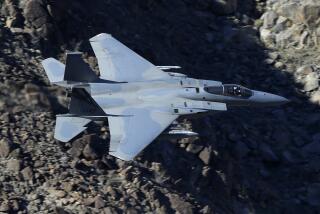SAC, Nation’s Nuclear Shield, Is Dissolved
- Share via
OMAHA — The Air Force, bidding farewell to an era, on Monday dismantled one of its most colorful and controversial Cold War commands and christened a successor designed for a world of Persian Gulf-style conflicts.
Under rainy skies, the Strategic Air Command laid down its organizational shield in a cavernous hangar thundering with the sound of martial music.
Its 950 intercontinental ballistic missiles and hundreds of long-range bombers were turned over to the new “Air Combat Command,” created Monday at Langley Air Force Base in Virginia. SAC’s stark insignia--a mailed fist clutching a lightning bolt--will be retired to the museums that house America’s military lore. Its motto, “Peace is Our Profession,” is likely to be picked up by the successor organization.
“There is a sense in which you could say . . . that the Strategic Air Command won the war that it was established to fight, the Cold War,” said Gen. Merrill A. McPeak, the Air Force chief of staff. “So, with the rearrangement of global . . . circumstances, we simply had to take another look and see are we organized properly for the new world order.”
The dissolution of SAC has come after two years of tumultuous change in the world and in the Omaha-based unit conceived and shaped to fight a global nuclear war against the Soviet Union. In July, 1990, SAC took its fleet of “doomsday planes” off 24-hour airborne alert.
Since the height of the Cold War, the airborne command centers had conducted round-the-clock operations to ensure that the nation’s nuclear arsenal could fight a protracted nuclear war even if it came under attack. Last September, President Bush ordered most U.S. missiles and the entire fleet of bombers off day-to-day alert.
“For 46 years, SAC held in its hands the ultimate weapons of war and the essential key to peace,” Gen. Colin L. Powell, chairman of the Joint Chiefs of Staff, said at Monday’s ceremony here. “Their job complete, their war won, we bid farewell to SAC. . . . Thank you, Strategic Air Command. Job well done! Enjoy your retirement.”
Air Force Secretary Donald B. Rice called the shake-up, which will reduce 13 major air commands to 10, “the most massive restructuring of the Air Force” since the service was established in 1947. The centerpiece of the Air Force reorganization is the consolidation of the Strategic Air Command and the Tactical Air Command into the Air Combat Command.
On Monday, however, McPeak and Rice also officiated at the establishment of the Air Mobility Command, which will consolidate refueling aircraft from SAC with the nation’s fleet of transport and aeromedical planes.
Such consolidations are expected to help the Air Force trim its rolls 23% and to create units in which fighter, attack, electronic jamming and bomber aircraft personnel would train together daily for the first time. The results would be an Air Force structure with fewer headquarters--and headquarters staff--and greater flexibility, with Stealth fighters and B-52 bombers working side by side.
“We’re making history today,” said McPeak. “We are present at the creation of a new and better Air Force. . . . We are instituting basic changes here, not just tinkering at the margins.”
Those changes eventually will bring the Air Force’s nuclear bombers and ICBMs under the command of a naval officer--an event without precedent in the days of SAC. On Monday, Gen. George L. Butler relinquished command of the 46-year-old SAC and became the commander of a new, joint-service command--the Strategic Command--which during wartime would oversee the deployment of the U.S. nuclear arsenal--of missiles, bombers and submarine-based missiles.
Although Butler is the new unit’s first commander, he will be succeeded by a naval officer. The unprecedented arrangement has caused consternation in both services, which have never before had to share command of their nuclear deterrent forces with each other.
More to Read
Sign up for Essential California
The most important California stories and recommendations in your inbox every morning.
You may occasionally receive promotional content from the Los Angeles Times.














